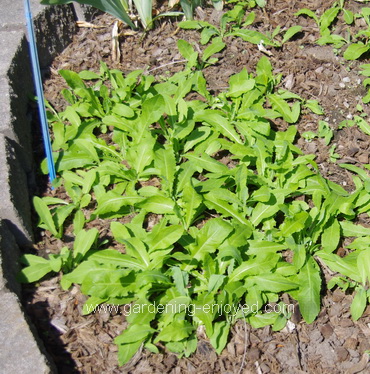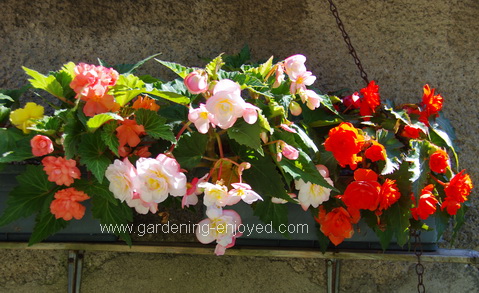| Back to Back Issues Page |
 |
|
Dallying In The Dirt, Issue #269 - A falling Walnut fails to knock any sense into me. August 27, 2016 |
 Maybe a good knock on the head would make see sense but I tried that this week and I don’t see much change except for a few day’s of headache. I was quietly sitting on the deck enjoying my breakfast when I suddenly felt a huge blow to the top of my head. That big green object is a walnut and I was sitting under its tree. It’s a tall tree so that nut probably accelerated for 25+ meters before finding my head. Luckily it cracked the walnut but not my head although it did knock off my glasses and leave me in a rather dazed state for a considerable period of time. I often wear a hard hat when working near that tree at this time of year because I have seen the force with which those nuts hit the ground but I had just finished and hour or so of watering and other early morning chores and was just quietly reading my paper and relaxing. I continue to have a love/hate relationship with that tree. It is a huge and attractive feature of the back yard and it provides some
wonderful deep cool shade for the deck but it drops a mass of fruit that needs to be picked up and its roots inhibit the growth of many vegetable plants. It’s technically my neighbour’s tree so I will get my hard hat out of the cupboard and appreciate its shade while gathering the thousands of bits of shell that the local army of squirrels drops all over the deck.
Maybe a good knock on the head would make see sense but I tried that this week and I don’t see much change except for a few day’s of headache. I was quietly sitting on the deck enjoying my breakfast when I suddenly felt a huge blow to the top of my head. That big green object is a walnut and I was sitting under its tree. It’s a tall tree so that nut probably accelerated for 25+ meters before finding my head. Luckily it cracked the walnut but not my head although it did knock off my glasses and leave me in a rather dazed state for a considerable period of time. I often wear a hard hat when working near that tree at this time of year because I have seen the force with which those nuts hit the ground but I had just finished and hour or so of watering and other early morning chores and was just quietly reading my paper and relaxing. I continue to have a love/hate relationship with that tree. It is a huge and attractive feature of the back yard and it provides some
wonderful deep cool shade for the deck but it drops a mass of fruit that needs to be picked up and its roots inhibit the growth of many vegetable plants. It’s technically my neighbour’s tree so I will get my hard hat out of the cupboard and appreciate its shade while gathering the thousands of bits of shell that the local army of squirrels drops all over the deck.  If anything will drive me to move to a gardenless condo, it will be weeds. Ever present, never ending and capable of surviving, no, actually thriving, under heat and drought conditions that keep the desirable plants struggling. Sonchus arvensis must be one of my best friends because this perennial Sow Thistle, takes all the abuse I can heap upon it and returns again and again. This picture is a small section of a bed that has a mass of Narcissus blooming in it during the spring. I finally got around to cleaning it up about three weeks ago and removed several large examples of Sonchus. It has a deep wide ranging root system and I did what I could to remove as much of that root structure as possible. I cannot just dig up the whole area as that would disturb the large cluster of Narcissus bulbs that have been increasing there for several years. Three weeks later those remaining bits of root have
produced the solid mass of growth that you can see here. I will go and attack it again and probably slow it down but I’m under no illusions that I could actually eradicate it without also destroying the Narcissus. I am certain that a deep digging and sifting would eliminate the Narcissus but I have grave doubts that it would have the same effect on this noxious weed. It is a relative of the Dandelion and apparently the young leaves are edible. Maybe I could teach the rabbits to like it and solve a couple of problems together.
If anything will drive me to move to a gardenless condo, it will be weeds. Ever present, never ending and capable of surviving, no, actually thriving, under heat and drought conditions that keep the desirable plants struggling. Sonchus arvensis must be one of my best friends because this perennial Sow Thistle, takes all the abuse I can heap upon it and returns again and again. This picture is a small section of a bed that has a mass of Narcissus blooming in it during the spring. I finally got around to cleaning it up about three weeks ago and removed several large examples of Sonchus. It has a deep wide ranging root system and I did what I could to remove as much of that root structure as possible. I cannot just dig up the whole area as that would disturb the large cluster of Narcissus bulbs that have been increasing there for several years. Three weeks later those remaining bits of root have
produced the solid mass of growth that you can see here. I will go and attack it again and probably slow it down but I’m under no illusions that I could actually eradicate it without also destroying the Narcissus. I am certain that a deep digging and sifting would eliminate the Narcissus but I have grave doubts that it would have the same effect on this noxious weed. It is a relative of the Dandelion and apparently the young leaves are edible. Maybe I could teach the rabbits to like it and solve a couple of problems together.Now it’s time to answer a few of my reader’s questions. Don’t forget to check the front page of the Website for frequent short ideas for current gardening activities. |
| Back to Back Issues Page |
